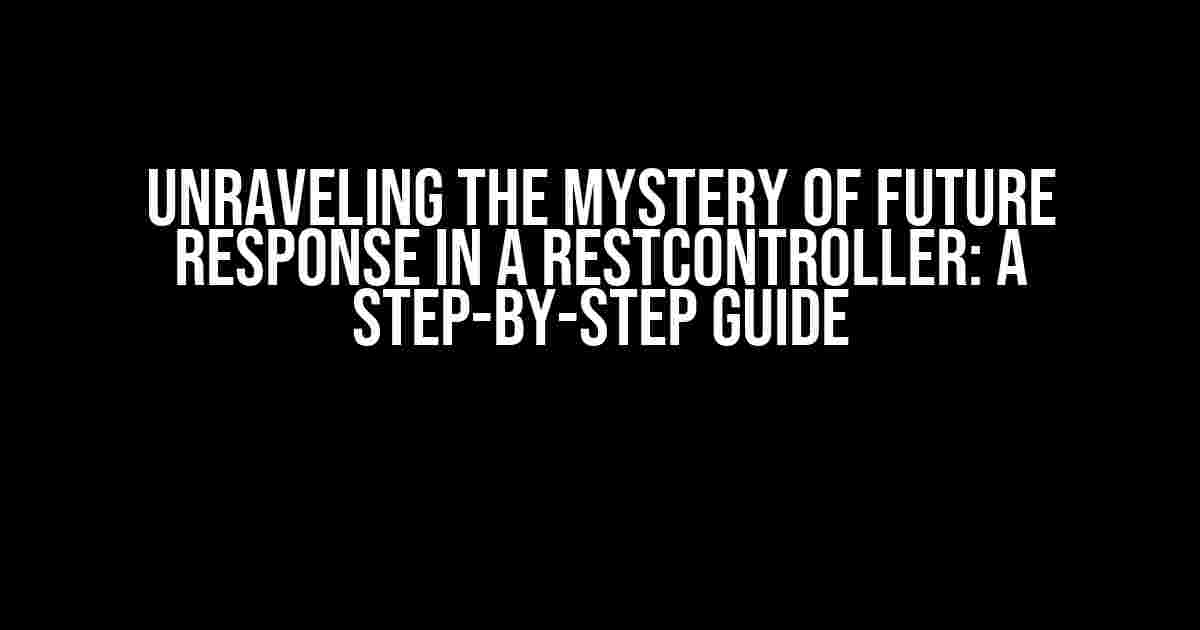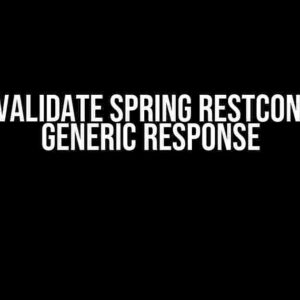Are you tired of receiving futures instead of actual responses in your RestController? Do you find yourself scratching your head, wondering why your API isn’t working as expected? Fear not, dear developer, for you’ve stumbled upon the right article! Today, we’ll delve into the world of futures andasync programming in Spring, and explore the reasons behind this peculiar phenomenon.
What is a Future Response?
A Future response, in the context of a RestController, refers to a result object that is used to retrieve the outcome of an asynchronous operation. It’s a promise that the operation will complete at some point in the future, hence the name. When a Future response is returned, it indicates that the actual response is not yet available, and the client needs to wait for the operation to complete.
Why Do We Need Futures?
Futures are an essential component of asynchronous programming, allowing us to write more efficient and scalable code. In a RestController, futures enable us to:
- Handle long-running operations without blocking the main thread
- Improve responsiveness by returning control to the client immediately
- Enable parallel processing and concurrency
The Problem: Futures Instead of Actual Responses
Now, let’s get to the crux of the matter. When a RestController returns a Future response, it’s supposed to contain the actual data once the operation completes. However, what if the Future response itself is returned instead of the actual data? This is where things get confusing.
To illustrate this, let’s consider an example:
@GetMapping("/users")
public CompletableFuture<List<User>> getUsers() {
return userService.getUsersAsync();
}
In this example, the `getUsers()` method returns a `CompletableFuture` containing a list of users. However, when we call this method from a client, we might receive a response like this:
{
"StackTrace": null,
"Message": null,
"InnerException": null,
"HelpURL": null,
"ErrorCode": null,
"Data": null,
"TargetSite": null,
"HResult": -2146233027,
"Source": null
}
Uh-oh! Instead of the expected list of users, we’ve received a Future response with no actual data. What’s going on?
Reasons Behind the Future Response
There are several reasons why a RestController might return a Future response instead of the actual data:
- Incorrect usage of async methods: When an async method is called without awaiting its completion, the Future response is returned immediately, containing no actual data.
- Lack of thread synchronization: If the async operation is not properly synchronized, the Future response might be returned before the operation completes.
- Incompatible serialization: The Future response might not be serializable, causing the actual data to be lost during transmission.
- Misconfigured async settings or incomplete Future completions can lead to the Future response being returned instead of the actual data.
Solving the Future Response Conundrum
Now that we’ve identified the culprits, let’s explore the solutions to our problem:
1. Awaiting Async Methods
When calling an async method, make sure to await its completion using the `await` keyword (in C#) or the `get()` method (in Java):
@GetMapping("/users")
public List<User> getUsers() {
return userService.getUsersAsync().get();
}
2. Thread Synchronization
Ensure that your async operations are properly synchronized using mechanisms like locks, atomic variables, or thread-safe data structures:
@GetMapping("/users")
public List<User> getUsers() {
synchronized (userService) {
return userService.getUsersAsync().get();
}
}
3. Serialization Configuration
Configure your serialization settings to handle Futures correctly. For example, in Spring, you can use the `@ResponseBody` annotation to enable serialization of Futures:
@GetMapping("/users")
@ResponseBody
public CompletableFuture<List<User>> getUsers() {
return userService.getUsersAsync();
}
4. Completing Futures
Ensure that your Futures are completed correctly, and the actual data is available when the Future is resolved:
@GetMapping("/users")
public CompletableFuture<List<User>> getUsers() {
CompletableFuture<List<User>> future = new CompletableFuture<>();
userService.getUsersAsync().thenAccept(users -> future.complete(users));
return future;
}
Conclusion
In conclusion, a Future response in a RestController can be a frustrating experience, but it’s not an insurmountable problem. By understanding the reasons behind this phenomenon and applying the solutions outlined above, you’ll be well on your way to resolving the issue and receiving the actual responses you expect.
Best Practices
To avoid Future response issues in the future (pun intended!):
- Await async methods to ensure completion
- Synchronize your async operations correctly
- Configure serialization settings to handle Futures
- Complete Futures correctly to ensure data availability
By following these best practices, you’ll be able to write efficient, scalable, and reliable RESTful APIs that return actual responses, not just Futures!
| Problem | Solution |
|---|---|
| Incorrect usage of async methods | Await async methods using await or get() |
| Lack of thread synchronization | Use locks, atomic variables, or thread-safe data structures |
| Incompatible serialization | Configure serialization settings to handle Futures |
| Incorrect configuration | Complete Futures correctly to ensure data availability |
Now, go forth and conquer the world of async programming, and remember: a Future response is not the end of the world – it’s just a challenge waiting to be overcome!
Frequently Asked Question
Get the scoop on Future responses in RestControllers and why they might be returning the wrong data!
Why does my Future response in a RestController return the future data instead of the actual response?
When you return a Future in a RestController, it’s essentially like saying, “Hey, I’ll get to this response eventually, but for now, just take this Future object and deal with it!” The problem is, the actual response isn’t generated until the Future is resolved, and by that time, the request has already been sent back to the client. So, you get the Future data instead of the actual response. To fix this, you need to block the execution of the method until the Future is resolved, using something like `future.get()`.
What’s the difference between returning a Future and returning the actual response in a RestController?
When you return a Future, you’re essentially saying, “I’ll get to this response later, but for now, just take this promise that I’ll deliver.” On the other hand, when you return the actual response, you’re saying, “Here’s the data you requested, enjoy!” The key difference is that the Future is a placeholder for the response, whereas the actual response is the real deal. In a RestController, you want to return the actual response, not the Future.
How do I know when to use a Future response in a RestController and when to use the actual response?
Use a Future response when you need to perform some asynchronous operation, like calling an external API or executing a database query. In these cases, you want to return a Future that represents the eventual result of the operation. On the other hand, if you’ve already got the data and just need to return it, use the actual response. Think of it like cooking a meal – if you’ve already cooked the meal, you can serve it directly. But if you need to cook the meal, you can promise to deliver it later and return a Future.
Can I use CompletableFuture to return the actual response in a RestController?
Yes, you can use CompletableFuture to return the actual response in a RestController. CompletableFuture is a powerful tool for working with asynchronous operations, and it can help you bridge the gap between the Future world and the actual response world. By using `CompletableFuture.completedFuture()` or `CompletableFuture.supplyAsync()`, you can create a Future that’s already resolved with the actual response, and then return that Future from your RestController method.
What are some best practices for working with Futures in RestControllers?
Some best practices for working with Futures in RestControllers include using `CompletableFuture` to simplify your code, avoiding blocking calls like `future.get()` whenever possible, and considering using an async framework like Spring WebFlux or Vert.x to handle asynchronous requests. Additionally, make sure to handle errors and exceptions properly, and consider using timeouts to prevent your application from hanging indefinitely. Finally, always remember to return the actual response, not the Future!


